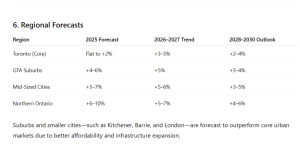1. Interest Rate Changes: The Central Catalyst
The Bank of Canada (BoC) has shifted from aggressive tightening to a cautious easing cycle:
- In December 2024, the BoC cut its policy rate from 4.5% to 3.75%, marking the fourth consecutive cut to support a slowing economy.
- By mid-2025, forecasts suggest the overnight rate could fall further, possibly reaching 2.25% to 3%.
- This easing has contributed to a modest housing market rebound. TRREB data from June 2025 shows home sales in the Greater Toronto Area (GTA) rose to a five-month high.
Interest rate changes like these have significantly reduced mortgage costs, making homeownership more accessible. Still, lingering economic uncertainty and job market weakness may limit a full-scale surge in demand.
2. Mortgage Rate Trends: Fixed vs. Variable
- Fixed rates are expected to stabilize between 3.75% and 4.0% for 5-year terms.
- Variable rates may dip below 3.6% as the BoC continues cutting rates.
The rate environment benefits both cautious and opportunistic buyers. Some are locking in fixed rates for predictability, while others prefer variable options in hopes of further declines.
3. Market Performance and Buyer Behavior
Sales and Listings
- The market ended 2024 on a weak note, with GTA sales in December down 6.8% year-over-year.
- However, by mid-2025, sales had rebounded. June saw a notable 8.1% increase in activity as interest rate cuts renewed buyer confidence.
Affordability Pressures
Despite these changes, affordability remains historically stretched. Mortgage delinquencies are rising—Ontario’s 90+ day delinquency rate has climbed to 0.24%, highlighting growing financial stress, particularly among recent buyers facing renewal at higher rates.
4. Renovation Trends and Home Depot Breaks
With high prices and tight market conditions, many homeowners are opting to renovate instead of move. This shift has increased demand for home improvement materials and services.
Home Depot, with 182 Canadian locations, has become a key player in this trend. Seasonal promotions known as Home Depot Breaks, including deals on insulation, HVAC, kitchens, and tools—have seen heightened interest, especially in 2025.
According to industry reports, Canada’s home improvement sector is valued at over $48 billion annually. Average project spending ranges between $11,000 and $15,000. These trends indicate that many Ontarians are choosing to build equity through renovation rather than face the competitive housing market.
5. Supply Constraints and Government Targets
Ontario’s goal of building 1.5 million homes by 2031 is ambitious, but not without challenges. Zoning delays, high construction costs, and skilled labor shortages continue to limit supply growth.
At the same time, listings have risen 16% in 2024, showing some seller willingness. Still, construction isn’t keeping pace with demand, particularly in high-growth areas like the GTA and mid-sized cities.

7. Risks and Policy Factors
Economic Pressures
The unemployment rate in Ontario remains elevated, approaching 6.9% by mid-2025. Slower job growth could hinder consumer confidence, even with favorable interest rate changes.
Policy Developments
Zoning reforms allowing laneway homes and multiplexes aim to increase supply, while transit investments are expected to support suburban growth corridors. However, the full impact of these measures may not be felt until the late 2020s.
Default Risk
Mortgage defaults could rise as more homeowners renew into higher-rate terms. This could affect prices and bank lending behavior, especially in overleveraged markets
8. Five-Year Forecast Summary
2025
- Market rebound driven by rate cuts.
- Suburbs and mid-sized cities see the most growth.
- Renovation activity peaks, with Home Depot Breaks highlighting seasonal trends.
2026–2027
- Steady price growth of 3–5% in most regions.
- Improved infrastructure and zoning reforms begin to support new housing.
- Mortgage affordability remains a concern for first-time buyers.
2028–2030
- The market enters the stabilization phase.
- Annual price growth moderates to 2–4%.
- Purpose-built rentals and renovations gain further traction.
9. Strategic Takeaways
- Buyers:
2025 may offer an ideal window to buy before rates settle and prices rise again, especially in growth markets like Durham, London, and Barrie. - Homeowners and Renovators:
Leverage Home Depot Breaks and similar deals to add value through renovations, particularly if moving is financially out of reach. - Investors:
Focus on mid-sized cities and new zoning regulations. Purpose-built rentals and multi-unit conversions could be the most profitable ventures in the years ahead. - Policymakers:
Accelerate zoning reforms, invest in skilled trades training, and expand affordable housing to prevent prolonged affordability issues.
Final Thoughts
Ontario’s real estate landscape over the next five years is shaped by three defining forces: interest rate changes, regional affordability shifts, and a growing renovation culture highlighted by trends like Home Depot Breaks.
While affordability challenges will persist, buyers, investors, and policymakers who adapt early to these shifts will be best positioned for long-term success. Stability is on the horizon, but only for those who prepare.






